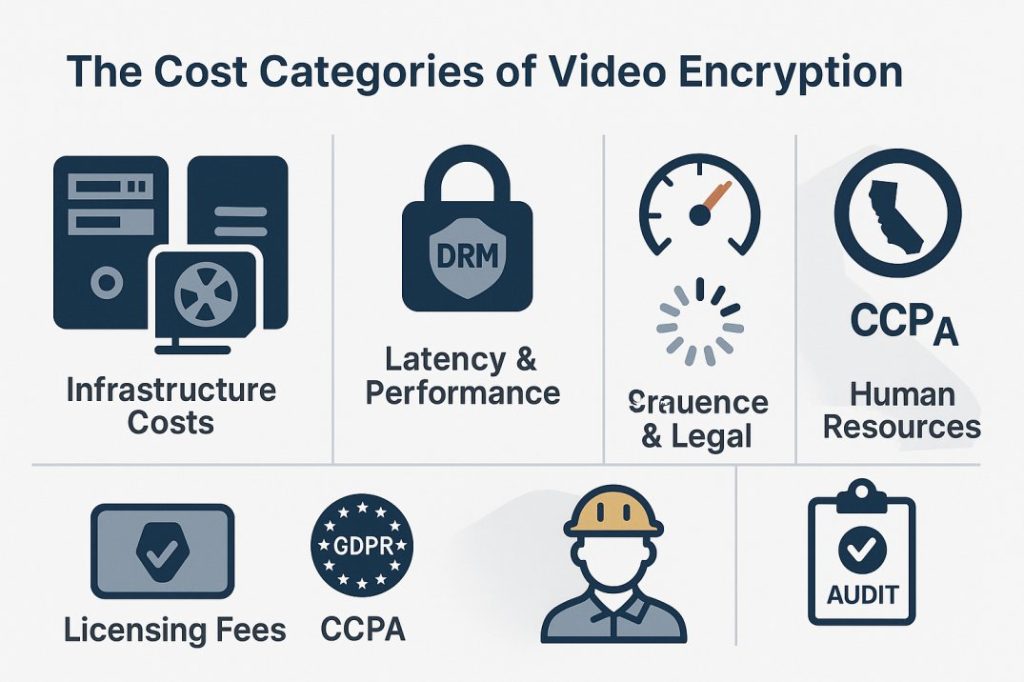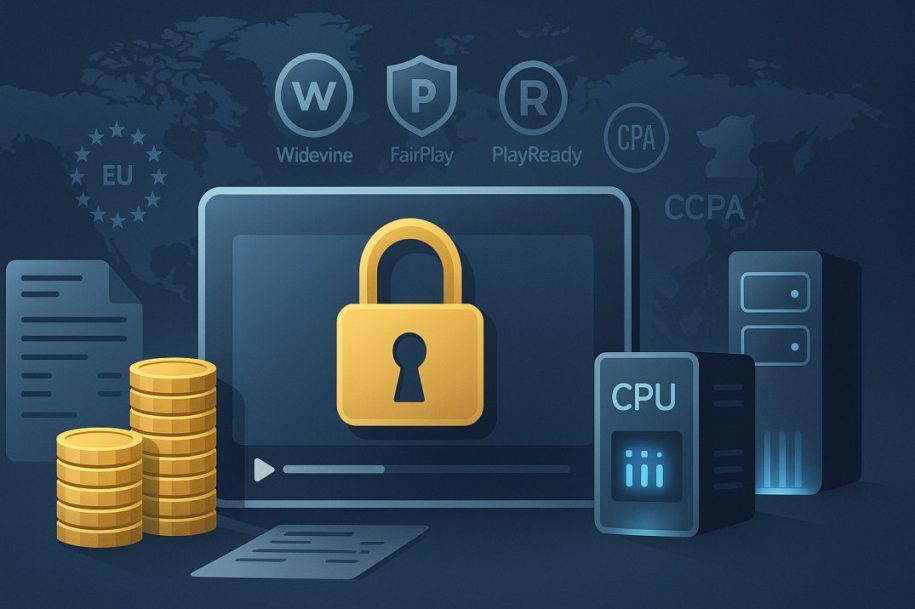Table of Contents
ToggleHow much does video encryption cost? As streaming platforms race to protect content, the hidden costs of encryption, licensing, latency, and storage demand closer scrutiny. Discover what’s at stake.
Key Takeaways: The True Cost of Streaming Video Encryption
Encryption is essential for content protection and regulatory compliance, but it comes with measurable costs across infrastructure, bandwidth, and operations.
Direct expenses include DRM licensing, encryption software, key management, and compliance certifications.
Performance overheads like CPU/GPU strain and added latency require investment in scalable, high-efficiency infrastructure, especially for 4K and live streaming.
Bandwidth and storage demands increase by 15–30%, inflating CDN fees and cloud storage costs while requiring smarter bitrate and delivery optimizations.
Device and platform fragmentation mandates multi-DRM integration and customized delivery pipelines for global compatibility.
Legal compliance across regions (GDPR, CCPA, COPPA) adds recurring costs via audits, legal advisors, and automation tools to avoid steep penalties.
Talent and training are often underestimated—DRM integration, cybersecurity certification, and compliance roles carry significant annual overhead.
Small to mid-size platforms should strategically encrypt only premium content and leverage SaaS-based encryption to stay lean and compliant.
Encryption ROI is long-term—it protects revenue, builds subscriber trust, and differentiates platforms in a privacy-focused streaming landscape.
The Essential Cost of Encrypting Streaming Video
Video encryption is non-negotiable for protecting premium content from piracy and safeguarding viewer privacy. Yet implementation carries tangible financial and performance trade-offs that media companies, content creators, and streaming platforms must strategically navigate. This article breaks down encryption’s true cost dimensions:
Infrastructure overhead: Compute resources for encoding/decryption
Licensing fees: DRM (Widevine, FairPlay, PlayReady) and key management
Latency impact: Encryption/decryption cycles affecting stream start times
Operational complexity: Integration with CDNs, players, and analytics
Direct Costs of Video Encryption Technologies
Implementing professional-grade encryption incurs unavoidable direct expenses, including:
Specialized encoders (e.g., AWS MediaConvert, Bitmovin) or GPU-accelerated servers,
Software-defined solutions like Shaka Packager.
Licensing Fees:
DRM licenses (Google Widevine, Apple FairPlay, Microsoft PlayReady),
Key management services (AWS KMS, Azure Key Vault).
Maintenance & Compliance:
Mandatory algorithm updates (AES-128 to AES-256 migrations),
Security audits and penetration testing,
GDPR/CCPA compliance certifications.
Computational Overheads of Video Encryption
Video encryption imposes significant computational burdens that directly impact infrastructure and sustainability:
CPU/GPU Load Surge:
Real-time AES-256 encryption devours 20-40% more CPU resources per stream,
GPU-accelerated encoding (NVIDIA T4/A100) becomes essential for 4K+/HDR content.
Hardware Scaling Costs:
Requires 30-50% more server instances versus unencrypted streams,
Edge computing nodes needed for sub-100ms decryption.
Energy & Carbon Impact:
Increases power consumption by 25-35% per streaming hour,
Mandates carbon-offset strategies for eco-compliance (ISO 14001).
Network & Bandwidth Impact of Video Encryption
Encryption reshapes video delivery dynamics with critical network implications:
Bandwidth Inflation:
Encrypted streams expand 15-25% due to AES overhead,
Forces 4K/HDR bitrate adjustments to avoid CDN surcharges.
Congestion Risks:
Peak-hour encrypted traffic strains last-mile networks,
Triggers buffering without QoS (Quality of Service) protocols.
Transmission Costs:
AWS CloudFront/Akamai bandwidth fees spike 20-40% for encrypted UHD,
Satellite/ISP data caps exhaust 30% faster.

Storage Costs of Encrypted Video: Strategic Planning
Storing encrypted video demands specialized infrastructure with critical cost implications:
Expanded Storage Footprint:
AES-256 encryption increases file sizes by 15-30% versus unencrypted assets,
Requires 40-60% more cloud storage (AWS S3, Azure Blob) or on-prem capacity.
Secure Storage Premium:
HIPAA/GDPR-compliant solutions (Backblaze B2, Wasabi) cost 2-3× standard storage,
Mandates zero-trust architecture with air-gapped backups.
Backup & Recovery Impact:
Longer RTOs (Recovery Time Objectives) due to decryption dependencies,
Egress fees multiply during disaster recovery scenarios.
Encryption’s Impact on Video Delivery & Playback
While essential for security, encryption introduces critical delivery challenges:
Latency Spikes:
Client-side decryption adds 200-500ms delay on average devices,
Causes visible buffering during start-up and bitrate switches.
Fragmented Device Compatibility:
Requires separate DRM implementations for iOS (FairPlay) vs. Android (Widevine),
Legacy Smart TVs need costly firmware updates.
QoS Demands:
Forces 30-50% higher CDN investment for SLA-backed 99.99% uptime,
Requires edge computing for sub-150ms decryption in live streams.
Compliance & Legal Costs of Video Encryption
Navigating global data privacy regulations imposes significant operational expenses:
Regional Compliance Complexity:
GDPR (EU): Requires AES-256 + explicit consent management
CCPA/CPRA (California): Mandates deletion tracking + opt-out mechanisms
COPPA (Child-directed content): Demands verified parental consent systems
Penalty Risks:
Up to €20M or 4% global revenue (GDPR)
$7,500 per intentional violation (CCPA)
Advisory Costs:
Legal consultants ($300–$500/hr)
Compliance automation tools (OneTrust, TrustArc)
Annual audits ($15k–$100k+)
Training & Personnel: The Hidden Cost of Video Encryption
Implementing enterprise-grade encryption demands specialized human expertise – often the most overlooked expense:
Certification & Training:
DRM-specific courses (Widevine/FairPlay deployment): $2,500-$5,000 per engineer,
Annual security recertification (CISSP, CompTIA Security+): $1,200+/person.
Specialized Talent Acquisition:
Security Architects ($140k-$220k/year),
DRM Integration Engineers ($120k-$180k/year),
Compliance Officers for GDPR/HIPAA streaming: $110k-$160k/year.
Implementation Costs of Video Encryption
Deploying encryption demands substantial upfront investment through resource-intensive integration:
Infrastructure Integration:
50–300 development hours for CDN/player pipeline compatibility (HLS-DASH),
Load testing across devices (iOS/Android/CTV) to prevent playback failures.
Customization Complexity:
Multi-DRM stacking (Widevine + FairPlay) for global releases,
Per-title encryption rules for mixed-content libraries.
Compliance & Testing:
SOC 2/GDPR validation audits ($15k–$50k),
Automated QoE monitoring for bitrate stability + VMAF quality scores.
Ongoing Encryption Maintenance & Monitoring Costs
Sustaining robust video encryption demands continuous investment beyond implementation:
Vulnerability Management:
Zero-day patching cycles requiring 24/7 DevOps attention,
Mandatory AES/DRM updates every 90-120 days.
Proactive Threat Defense:
SIEM tools (Splunk, Datadog) for anomaly detection,
24/7 Security Operations Center (SOC) monitoring,
MDR services for advanced threat hunting.
Breach Containment:
Incident response retainers ($50K-$200K/year),
Forensic investigations + GDPR breach fines (up to $4M),
Reputational damage control campaigns.
Economic Scale: Encryption's Variable Impact
Encryption costs for streaming services scale dramatically with operational size:
Enterprise Advantages:
Massive traffic volume enables 40-60% cost amortization via bulk DRM licensing,
Shared infrastructure across content libraries slashes per-title expenses.
SMB Strategic Balancing:
Prioritize encryption for high-value content (live events, exclusives),
Use SaaS solutions to avoid CapEx with usage-based pricing models.
Conclusion: Security as Competitive Infrastructure
While video encryption imposes costs, its ROI manifests through:
Revenue Protection: Stopping piracy leakage (5-15% industry revenue loss),
Trust Capital: GDPR/CCPA compliance preventing 7-figure fines,
Market Positioning: “Secure Stream” badges boost subscriber retention 20-30%.
Inkrypt Videos delivers scalable encryption: From indie creators to media conglomerates, we optimize security spend while future-proofing compliance. [Book a Security Audit] to pinpoint your ideal cost/risk balance.
FAQs
Costs depend on video volume, storage duration, bandwidth, encryption type, and required security level. Higher security and longer storage typically increase expenses
Encryption can add costs for software, licensing, and increased processing. Expect higher charges for premium encryption or DRM, billed per usage or storage
Encryption protects video content from unauthorized access, piracy, and ensures user privacy, making it essential for premium or sensitive streams
Content owners, streaming platforms, or businesses distributing video usually pay for encryption as part of their security and compliance measures
Cloud services often bill based on storage, bandwidth, streaming hours, and security features like encryption or DRM, using a pay-as-you-go model
Upgrade encryption when handling sensitive, high-value, or copyrighted content, or when legal compliance and user privacy are priorities
Challenges include added latency, increased CPU usage, compatibility issues, and higher costs for advanced security features
Encryption can slightly increase latency and CPU load, but modern algorithms minimize performance drops for most users
Not all devices support encrypted streaming; compatibility depends on the player and encryption method used
No, DRM includes encryption but also manages user access and usage rights for extra protection
Use built-in encryption from trusted cloud providers and enable only necessary security features to control costs
Some open-source tools offer basic encryption, but advanced features and support usually require paid services

